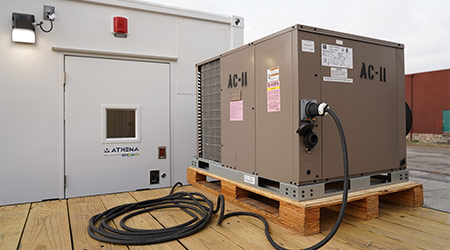In addition to new vaccines and tests, the battle against COVID-19 has another effective tool to deploy: quick response, mobile, customizable containers, trailers, and vehicles that can be configured into labs, vaccination clinics, and essentially whatever is required for effective treatment on the front lines — and then repeatedly moved to successive crisis points.
One example, the Athena Mobile Laboratory, a state-of-the-art, rapidly deployable mobile lab housed in a customizable container structure, is already being utilized in several U.S. Department of Defense facilities for COVID-19 testing of military service members and support staff, according to Christopher Hollars, Ph.D., Director, Emerging Technical Solutions at MRIGlobal, a non-profit, world leader in technology and science that works with government agencies, commercial businesses, and academic institutions to improve health and safety.
The mobile labs used for COVID-19 testing are typically equipped with diagnostic instrumentation and a biological safety cabinet that protects the analyst whenever the sample is exposed, says Hollars. In addition, a safety shower and eye-wash station were installed to mitigate incidental exposure.
While the mobile lab was readily adapted to COVID-19 testing and safety protocols, it was actually developed before the pandemic by MRIGlobal in partnership with St. Charles, Missouri-based Craftsmen Industries.
Prior to the pandemic, the mobile labs have been used for a variety of testing applications including CBRNE and forensics laboratory space, and an earlier version was utilized for Ebola diagnostics testing in rural West Africa and are still in operation, according to Hollars.
Today, each COVID-19 mobile lab is built with design advancements identified by
MRIGlobal, which has over 15 years of experience with mobile medical and defense technology, but the final design is still completely customizable for highly specialized purposes.
One advantage of the Athena mobile lab design is its shipping and space efficiency. The structure is designed to remain condensed during transportation, keeping it in line with ISO shipping regulations. It easily loads on and off trailers, ships, railcars, and airplanes, enabling organizations to rapidly deploy across the globe, while reducing shipping cost. Onsite, an 18-foot section expands to provide 82 percent more floor space and 42 percent more work bench space over non-expanding designs.
Inside the mobile lab container, other aspects are designed to enhance safety, reliability, efficiency, and operator comfort. The floor is sealed and completely flat with hidden cargo tie-downs throughout. The walls are load bearing to eliminate the need for bulky table legs so technicians can move freely and reconfigure workspaces.
Access to power is designed to be a non-issue because the mobile lab is equipped with an electrical system that meets both international and domestic standards (U.S. 208/120V, 60 Hz or European 400/230V, 50 Hz) and has a uninterruptable backup battery system in case of power failure.
To help technicians function long hours in inhospitable environments, a scalable HVAC system maintains a comfortable air temperature, and a dimmable LED system provides lighting control according to need.
“The scalable, skid-mounted HVAC system we developed in collaboration with Craftsmen Industries connects to the lab through ducting that allows you to use essentially any size of commercially available HVAC unit and to use multiple units, so you can customize it to the intended worksite,” says Hollars.
Despite the sophistication of the mobile labs, new units can be completed from start to finish in as little as eight weeks, with nearly finished in-stock labs completed in about two weeks, says Hollars.
With the list of FDA COVID-19 vaccines approved for emergency use growing, Hollars understands the value offered in customizable mobile container designs like Athena that can be configured to serve as a rapidly deployable vaccination clinic wherever needed.
“With COVID-19 vaccination needing to reach hundreds of millions of Americans, a rapid response mobile unit operating as a clinic could be located in the parking lot of healthcare facilities to add surge capacity, or brought to any hot spot or remote underserved area,” says Hollars.
A similar approach can also be used to provide emergency disaster relief as well as environmental testing, power, filtration, and clean water after hurricanes, floods, fires, earthquakes, etc. if configured to do so.
“After natural disasters, existing infrastructure can be damaged or compromised,” says Hollars. “So, a quick response unit that can provide necessary testing, healthcare, and disaster aid in various forms could be useful to FEMA, states, and municipalities as well as relief organizations,” says Hollars. He notes that such units can be designed to provide potentially decades of use, so can be reconfigured and repurposed, if its original use is no longer necessary.
While medical professionals have primarily utilized fixed healthcare infrastructure, the urgent need to provide testing, vaccination, and other services when pandemics or disasters strike make mobile and surge capacity more important than ever.
For this reason, it is crucial that healthcare and civic administrators investigate the possibility of using quick-response mobile, customizable containers, trailers and vehicles to safely meet medical and emergency relief demands wherever and whenever the need arises.

 UF Health Hospitals Rely on Green Globes to Realize Their Full Potential
UF Health Hospitals Rely on Green Globes to Realize Their Full Potential How Healthcare Facilities Can Be Truly Disaster-Resilient
How Healthcare Facilities Can Be Truly Disaster-Resilient TriasMD Breaks Ground on DISC Surgery Center for San Fernando Valley
TriasMD Breaks Ground on DISC Surgery Center for San Fernando Valley Bigfork Valley Hospital Falls Victim to Data Breach
Bigfork Valley Hospital Falls Victim to Data Breach AI-Driven Facilities: Strategic Planning and Cost Management
AI-Driven Facilities: Strategic Planning and Cost Management